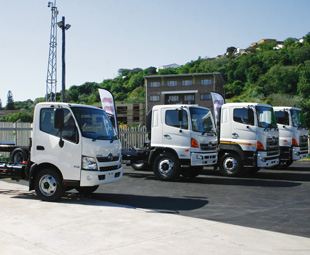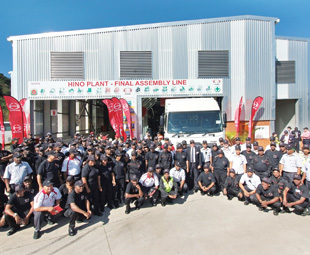Hino’s new home

Toyota South Africa Motors – or TSAM, as it’s affectionately called by insiders – has significantly upgraded its Prospecton plant. Hino invited us along
The year was 1972, and a new brand of commercial vehicle was rolling out of a small plant in Prospecton, Durban. DA110 and Super Dolphin were some of the legendary names to have emerged from the area, and now, 42 years later, the plant where all Hino models on South African roads originated, has a new home.
Construction on the new Hino truck plant began at the end of 2013, meaning the contractors had a mere 27 weeks in which to complete the project. Despite some rather inclement weather and a total of 52 days of rain, the 11 500 m2 facility was completed on time.
 With a total investment of R55 million, the new plant forms part of a continuous investment in the Prospection facility by TSAM, totalling R1 billion.
With a total investment of R55 million, the new plant forms part of a continuous investment in the Prospection facility by TSAM, totalling R1 billion.
Chairman of the board of Hino Motors Limited, Masakazu Ichikawa, who recognised the importance of the plant and attended the opening from Japan, notes that last year Hino South Africa sold a record 3 461 units, placing it in ninth place among markets outside Japan. He adds that the new plant will form a base for further expansion into other southern African markets. (Hino trucks sold in other African markets are currently brought in from Japan.)
“We recognise the importance of African markets as they are showing rapid growth and have high potential. The South African market is particularly challenging with major brands, from Europe, the United States, Japan, China, India and Korea, competing for a comparatively small number of sales,” Ichikawa says.
TSAM president and CEO, Johan van Zyl, adds: “As a group company, Toyota is committed to the Hino brand and this investment underlines just how serious we are about trucking – as per the Hino brand campaign launched in 2013, we will Keep on Truckin’.”
With 109 employees, the new plant can produce 5 000 vehicles a year on a single shift. This can be increased if demand requires it. Naturally, Hino took the opportunity to improve workflow and quality control in vehicle production. This includes a consolidated logistics area for the 31 model derivatives and the installation of a dynamic functional testing station, which allows technicians to check each vehicle, to exact standards in a controlled environment, before signing it off.
 Also introduced is a new assembly principle, called the Jundate Principle. It allows for sub components to be assembled away from the main assembly line before being delivered in sequence to the line just in time (JIT) to be fitted to the unit on the line. This is to the benefit of productivity and quality.
Also introduced is a new assembly principle, called the Jundate Principle. It allows for sub components to be assembled away from the main assembly line before being delivered in sequence to the line just in time (JIT) to be fitted to the unit on the line. This is to the benefit of productivity and quality.
The plant’s employees have also been a focal point, with the new plant even more conducive to safer working conditions with bright, clearly defined work areas. The layout of the new facility has also improved working conditions and process flow. Rounding it off are the upgraded canteen and ablution facilities.
Allied to the significant, ongoing investment by Hino dealers (which has totaled R100 million since 2010), the new plant is another step in line with the company’s promise to help its customers Keep on Truckin’ – something the company will certainly do for the next 42 years, and the next, and the next.
Published by
Focus on Transport
focusmagsa




